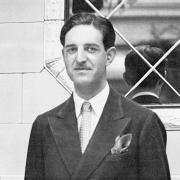A new museum in a Lytham landmark recalls a tragedy which changed the face of the RNLI, as Paul Mackenzie reports. Photography by John Cocks

The sun glints on the water and a gentle breeze ruffles the feathers of the wading birds in the Ribble estuary mud. The promenade beside Lytham Green is filled with walkers and cyclists, families on a day trip and children playing, their laughter mingling with the cries of the gulls as boats with triangular sails drift effortlessly by on the peaceful water.
It’s hard to picture a more tranquil scene and even when the murky waters are reflected in the slate grey skies and wind and rain reduce the numbers out on the prom to a hardy few, nothing that happens on those waters can compare to the drama that unfolded shortly before Christmas 1886 when a terrible storm drove the German ship The Mexico onto a sandbank.
The vessel, which was sailing from Liverpool to Ecuador, fired distress signals at 9pm and an hour later the Lytham lifeboat crew were rowing through the churning waters. Crews from Southport and St Annes set out a short time later.

The 12 men in The Mexico’s crew were lashed to the rigging as gale force winds battered the ship and rain, sleet and snow made conditions almost unbearable. As the Lytham lifeboat approached the stricken ship a sudden squall capsized the lifeboat and broke three oars.
The lifeboat crew recovered and managed to pull alongside the Mexico. One by one the crew lowered themselves by rope on the rescue boat which was being tossed by the ferocious waves. Another oar was broken as the rescuers started to move back to shore.
A large crowd had gathered at Southport and assumed the returning boat was carrying the crew from the town but the lifeboat continued past the lights towards Lytham. Moments later a huge wave capsized the Southport boat. Only two of the 16-strong crew survived.

In Lytham there were cheers as the lifeboat was brought safely back to shore shortly after 3am and the rescued sailors were taken to the Railway Hotel, in Station Road.
But a couple of miles up the coast the crowd of people waiting for the return of the St Annes boat were starting to fear the worst. When day broke telegrams were sent to lifeboat stations along the coast in the hope that the crew had found shelter elsewhere. The replies were all negative and the tragic news from Southport deepened the mood of grief among the worried relatives.
With the wind still raging, the same Lytham crew set sail again to hunt for their colleagues. They were joined in the search by the crews from Blackpool and Southport and in the early afternoon, the St Annes lifeboat was found, bottom up on the beach at Birkdale. The crew of 13 were all dead.

To save 12 strangers, 27 lifeboatmen had died leaving 16 widows and 50 orphans in three Lancashire towns a fortnight before Christmas.
The disaster, which is still the worst to affect the RNLI, is remembered in the Lifeboat Museum, which has be re-opened by the Lytham Heritage Group, in the Old Lifeboat House on Lytham Green from where the crew launched their boat on that fateful night 130 years ago.
The building had housed a museum which closed in 2004 but it opened again in April, and is now run by Steve Williams. His mum Marilyn Adams was one of the founders of the heritage group and ran the neighbouring Windmill Museum until her death in 2008.
Steve said: ‘She was a local heritage nutter, in a nice way, and she won various awards for the windmill over the years. I still feel she’s here with me. She’d be chuffed to bits to see the old lifeboat house open as a museum again. It would have been nice to work on it with her.’
Steve, who runs an engineering company in Blackpool, added: ‘It seemed logical to use the Mexico as the theme for this museum and we were looking for boats to restore and someone pointed us towards Hoylake which had a 1908 Liverpool class lifeboat which had been lovingly restored but the museum there was having difficulties and has now closed. This wasn’t what we had envisaged, but it’s not often you get offered a fully restored lifeboat.’
After it left the RNLI, the boat was re-named Peggy and was used as a pilot boat on the Lune but was found years later in a poor state on the Douglas. Now painstakingly restored, the boat, called Chapman, is the centrepiece of the museum and is a similar size to the Charles Biggs, which left Lytham to attend the Mexico.
The Lytham Windmill and Lifeboat Museums will be open from Wednesdays to Sundays, and Bank Holidays, between June 1 and September 18 from 10.30am-1pm, 2pm-4.30pm.
Hail the current crew
Peter Whalley is the operations manager for the current Lytham lifeboat crew who cover an area from Hoylake on the Wirral to Fleetwood, and out west as far as the Isle of Man.
On the night Lancashire Life met Peter and the current crew at the new lifeboat house, the weather showed how inhospitable the estuary can be, with rain, hail and bitingly cold winds battering the coast.
‘I wouldn’t want to be going out in that,’ says one member of the crew, hands thrust deep inside the pockets of a yellow waterproof coat. His crew mates murmur in agreement and edge further from the door until the downpour relents.
Many of the call-outs the crew attend are what Peter refers to as ‘AA work’, dealing with people who are in no immediate danger but who require some assistance. Some of the jobs however are more dramatic, such as the yacht sinking in near gale force winds near the mouth of the river. ‘That was quite a hairy one,’ Peter said. ‘One of the most rewarding was getting three children of St Annes pier. They were only about five or six and they’d be caught out by the tide and were getting quite hysterical.’
Most of the current crew and launch team work but it can take as little as ten minutes for a boat to be launched – either the inshore boat housed at Lytham’s new lifeboat house, or the larger boat which is kept at St Annes.
‘The boat we use will depend on the circumstances and the weather conditions,’ said Peter, who has been a member of the team since the 1970s. ‘You never really know what you’re going to or what you’ll find when you get there but most of them have happy endings.
‘We get really good training from the RNLI and although the team is made up of a wide range of people, everyone gets on very well. When you’re out in the boat you have to trust the people you’re with.’
And Digby Moulden, who is a member of the launch crew and the chair of the local fundraising team, added: ‘It’s really good fun. There’s such camaraderie among the team and we get very good support from people and businesses in Lytham and St Annes.’
* The RNLI relies on volunteer crew members and contributions from the public, which pay for lifeboats, equipment and training. For more information on the charity and how to help save lives at sea, telephone 0845 122 6999 or log on to www.rnli.org.uk



























